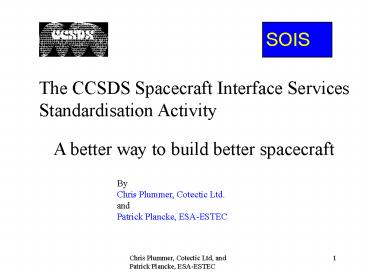The CCSDS Spacecraft Interface Services - PowerPoint PPT Presentation
1 / 20
Title:
The CCSDS Spacecraft Interface Services
Description:
Intranet or SNDCS. This heritage has led to the establishment of the first working groups ... This covers a raft of concepts that concern the portability and ... – PowerPoint PPT presentation
Number of Views:23
Avg rating:3.0/5.0
Title: The CCSDS Spacecraft Interface Services
1
SOIS
The CCSDS Spacecraft Interface Services Standardis
ation Activity
A better way to build better spacecraft
By Chris Plummer, Cotectic Ltd. and Patrick
Plancke, ESA-ESTEC
2
SOIS
Overview
Why we need SOIS
What SOIS is
Expected benefits
Why is it difficult?
SOIS in detail
Time critical onboard applications WG
Time critical onboard network services WG
Onboard bus and LAN WG
Onboard plug play BoF
Spacecraft transducer systems BoF
3
SOIS
Why we need SOIS - 1
We dont need to look far to see a host of
problems with the design and development of
spacecraft
Software/hardware dependencies integration
problems
Repeated engineering on each successive project
Difficulty developing software for new hardware
choices
Difficulty supporting new software architectures
Problems with interoperability
Uniqueness of spacecraft onboard interfaces
4
SOIS
Why we need SOIS - 2
SOIS aims to address these problems by
Standardising services and interfaces to reduce
the repeated development activities
Introducing an architectural structure that
isolates hardware and software
Standardising protocols to simplify
interoperability and cross support
Defining generically useful services
5
SOIS
What SOIS is
Since May 2003, SOIS is one of the key areas of
technical interest of the CCSDS.
This means that it has two permanent seats (out
of 14) on the CCSDS Engineering Steering Group
(CESG) SOIS AD DAD.
After discussion and approval from the CESG, the
AD and DAD can appoint ad-hoc working groups to
develop standards related to their area.
Resources are committed!
AD and DAD can also approve the establishment of
Birds-of-a- Feather groups to look at potentially
interesting concepts related to their area.
No resources committed to this stage!
6
SOIS
Expected benefits of SOIS
Reduced recurrent engineering.
Increased re-use potential.
Simplified integration and testing.
More modular designs.
Improved support for new software architectures.
Flexibility to adopt new technologies.
7
SOIS
So why is this difficult?
Which interfaces do we standardise?
???
Buses
Comms
Software
Power
Digital
Analogue
8
SOIS
So why is this difficult?
We need to talk with many different disciplines!
Payloads
???
Systems Eng.
Comms
SW Eng.
HW Eng.
9
SOIS
So why is this difficult?
The need dates are different
I need these in about 5 years
Definitely in 2010
Probably about 2020
Give them to me now!
If only youd given these to me yesterday
10
SOIS
So why is this difficult?
The requirements are evolving
New and distributed software architectures
More capability needed, less money available
Hardware technology is improving
Rate of obsolescence is accelerating
11
SOIS
SOIS in detail - 1
SOIS has inherited a lot of work from the CCSDS
P1K sub-panel.
The most important heritage is the layered
reference model.
Application
Transport
Network
Data Link Physical
12
SOIS
SOIS in detail - 2
We also had a number of generic services
identified
Command and data acquisition.
Time distribution.
File transfer.
Messaging.
Intranet or SNDCS.
This heritage has led to the establishment of the
first working groups
13
SOIS
SOIS in detail - 3 The working groups and BoFs
Time critical onboard application services (TCOA)
WG
Onboard bus and LAN WG
Onboard plugplay Concepts BoF
Time critical onboard network services (TCONS) WG
Spacecraft transducer Systems BoF
14
SOIS
Time critical onboard application services
Addresses the application layer of the SOIS stack.
Aims to define the generic services exposed
to user applications
Time distribution
Command and data acquisition
File transfer
Messaging
15
SOIS
Onboard bus and LAN working group
Application
Addresses the data link and physical layers.
Transport
Network
Aims to define the service that must be
provided by any underlying bus or LAN so that
they can be interchanged.
Data Link Physical
Target buses for near term prototyping are
MIL-STD-1553B, CAN, and SpaceWire.
16
SOIS
Time critical onboard network services
Application
Addresses the transport and network layers.
Transport
Network
Aims to define the services that are needed
to operate over multiple, possibly
heterogeneous underlying buses or LANs.
Data Link Physical
Big problem here is identifying a clear, present
day need for this type of service.
17
SOIS
Onboard plug-and-play concepts BoF
Application
Investigating the utility of plug-and-play
concepts for use onboard spacecraft.
Transport
Network
Data Link Physical
Probably has implications for several layers,
esp. application, but also network and physical.
This covers a raft of concepts that concern the
portability and mobility of software, dynamic
reconfiguration, and software maintenance.
18
SOIS
Spacecraft transducer systems BoF
Application
Investigating the application of sensor buses
and improved sensor/actuator technologies.
Transport
Network
Data Link Physical
Specifically looking at maturing technologies,
such as IEEE-1451, to see how they can improve
the spacecraft development and integration
processes.
Needs to address the physical layer implications,
e.g. enumeration, device discovery, and
application layer capabilities, e.g.
device access, configuration, etc.
19
SOIS
What we are doing wrong
We dont know our customers yet
We are much to slow to deploy standards
We havent clearly defined our products yet
We havent demonstrated the financial benefits yet
20
SOIS
Appeal
If any of our problems sound familiar
If any of our solutions sound useful
If you think we need to focus on something else
If you think we are getting things right
If you think we are doing it all wrong
We need to hear from you!
c.plummer_at_skynet.be
patrick.plancke_at_esa.int































